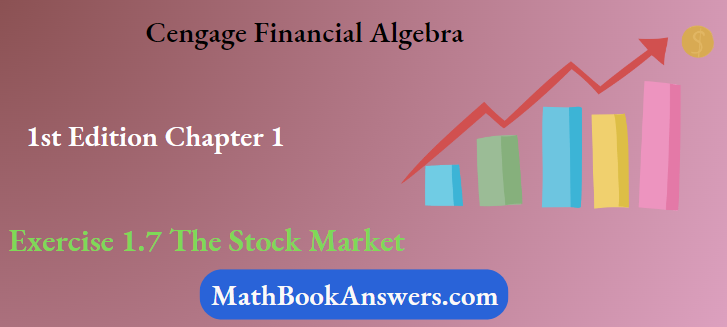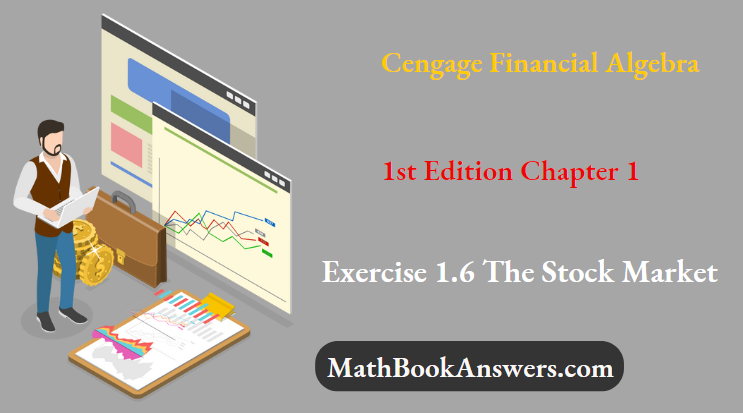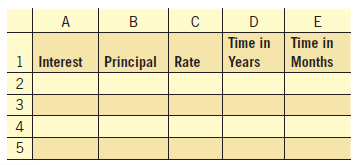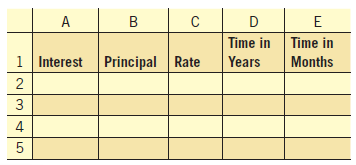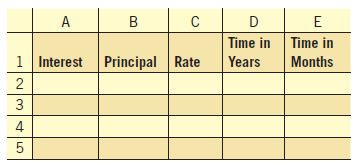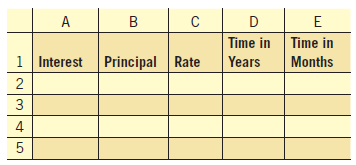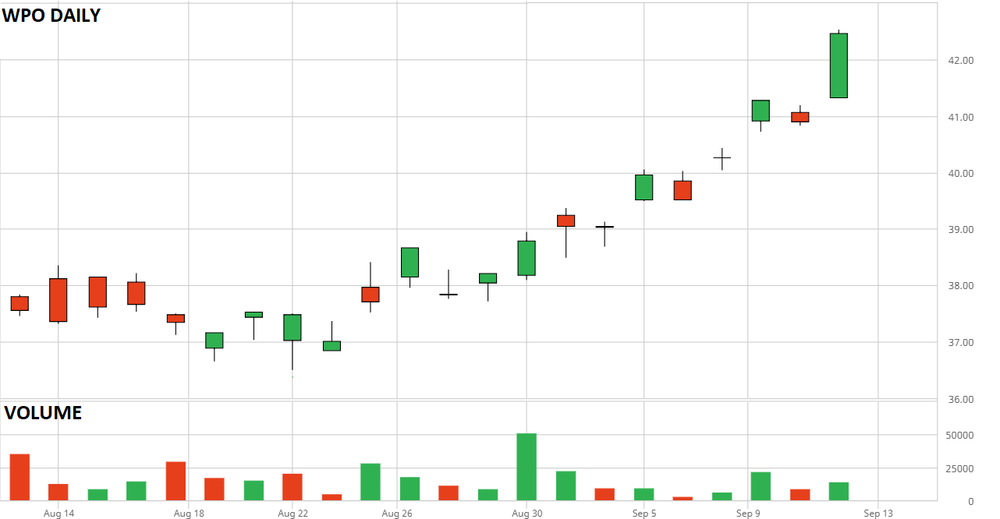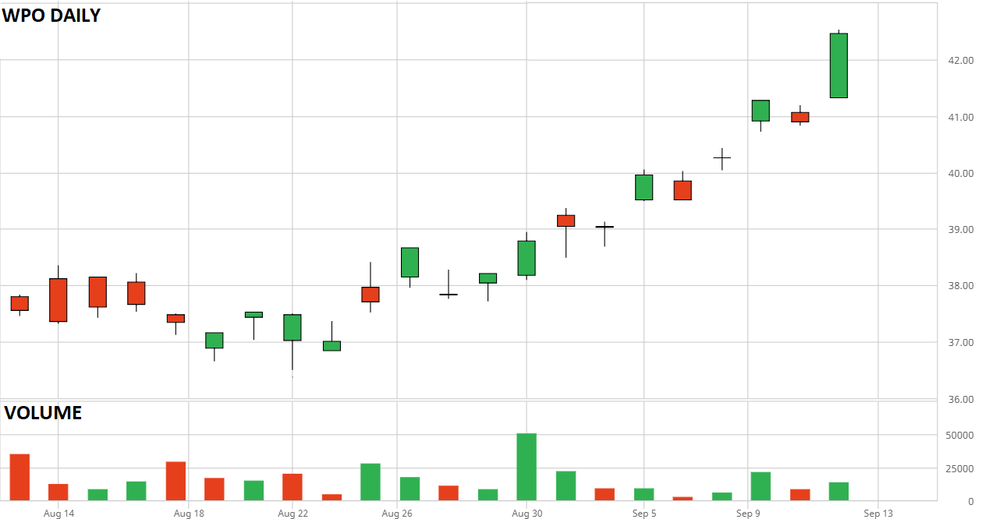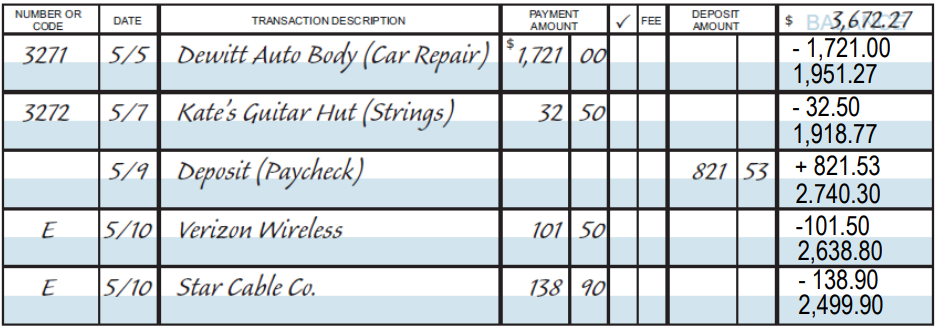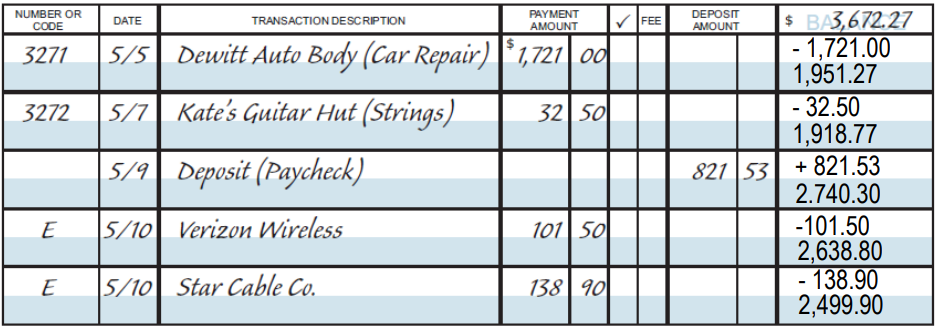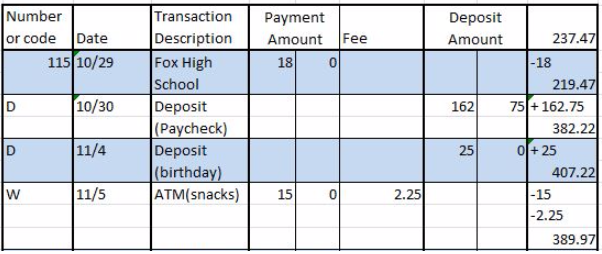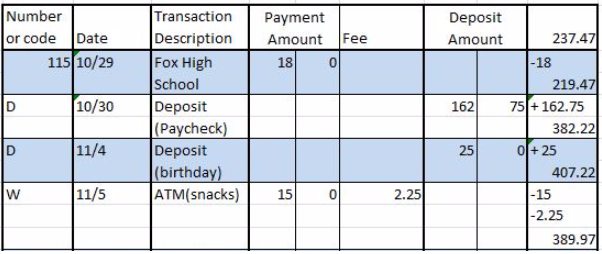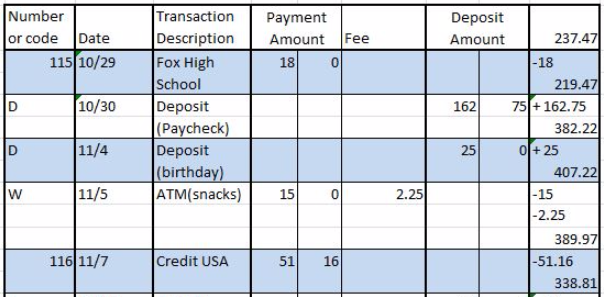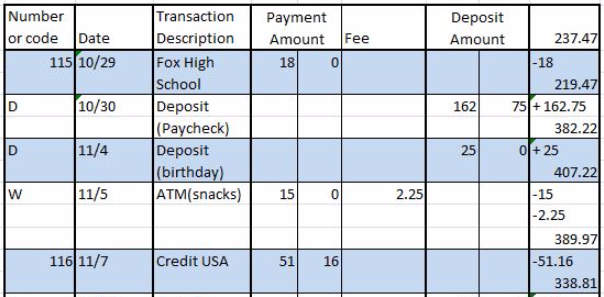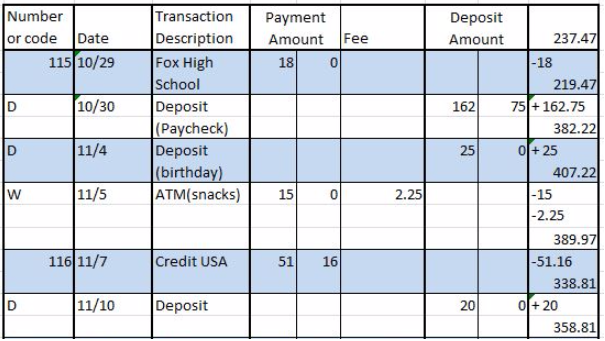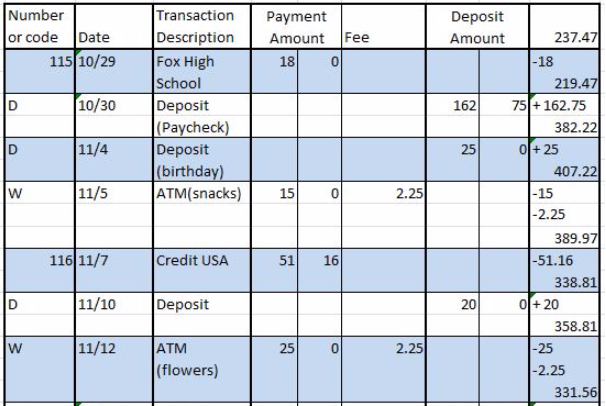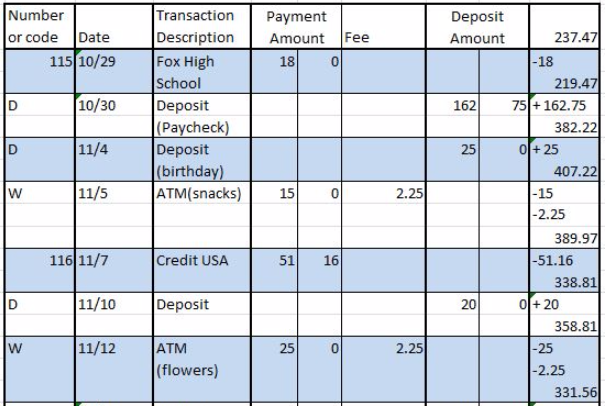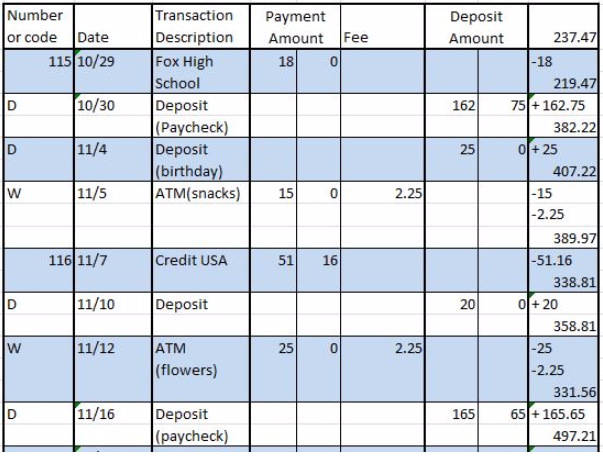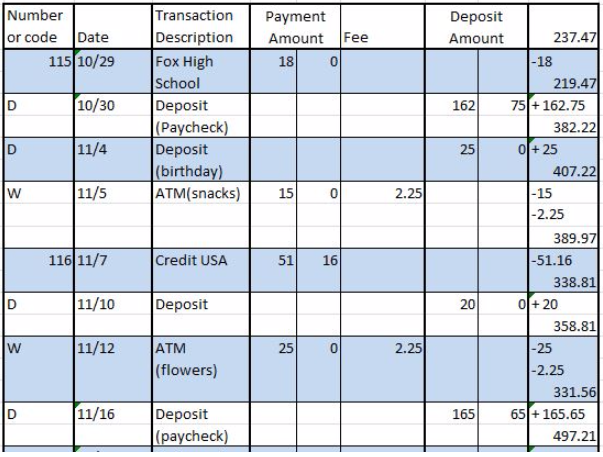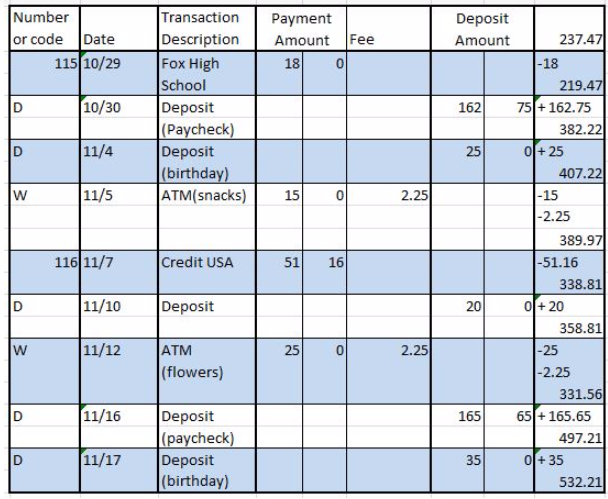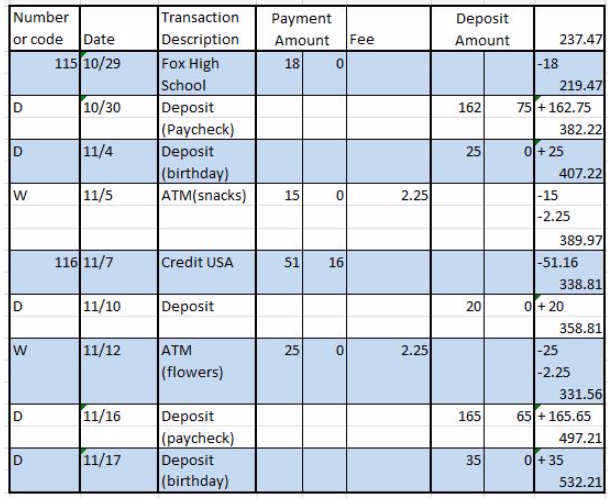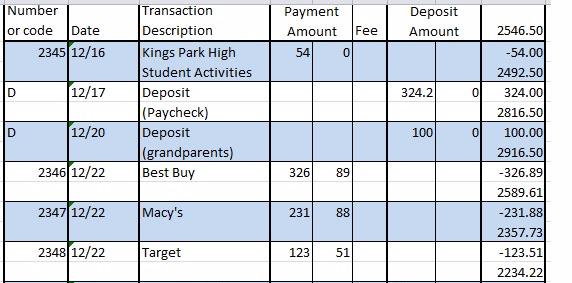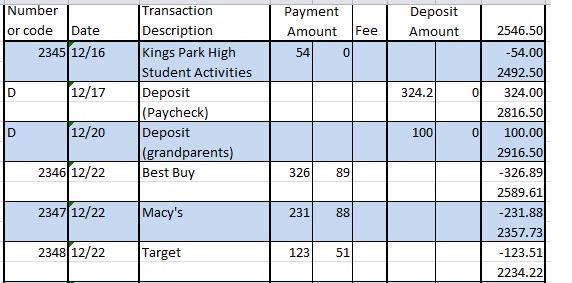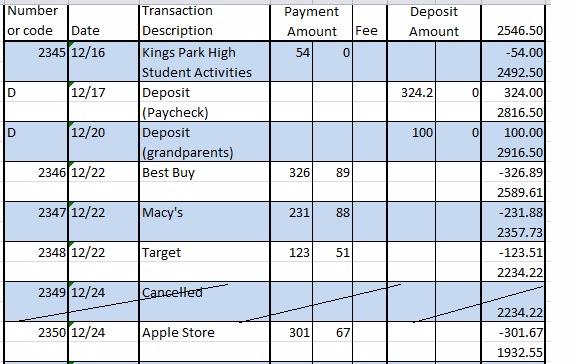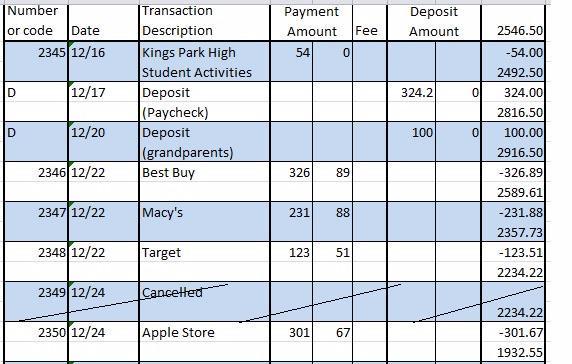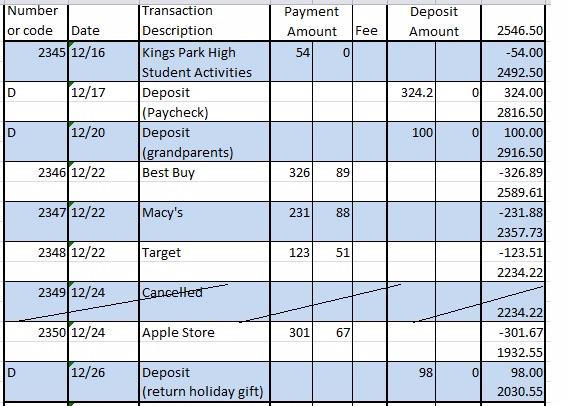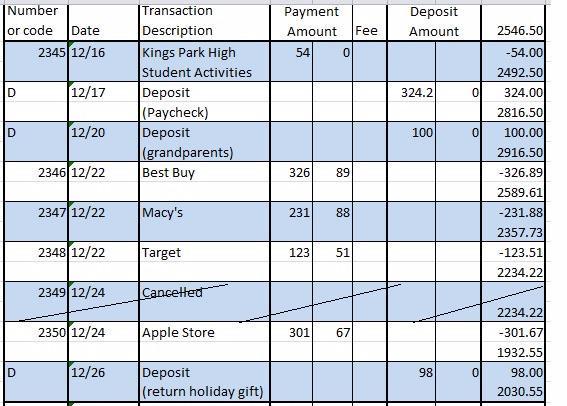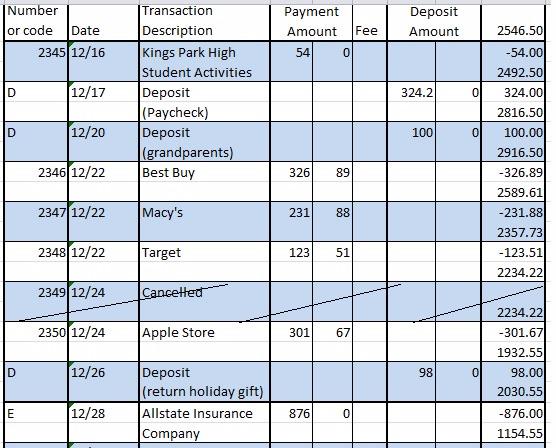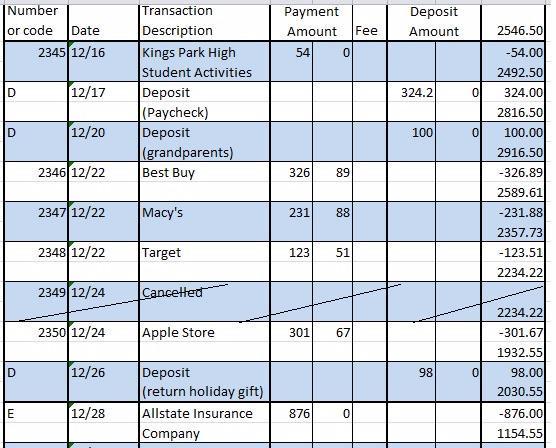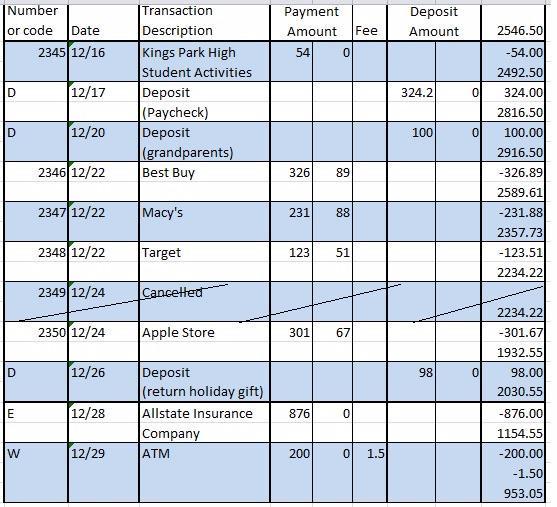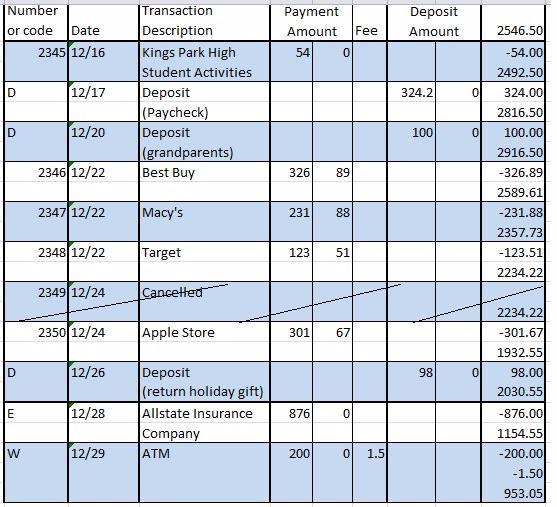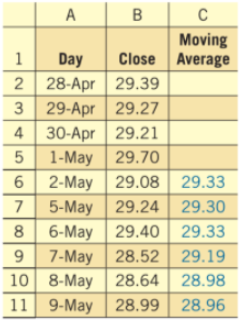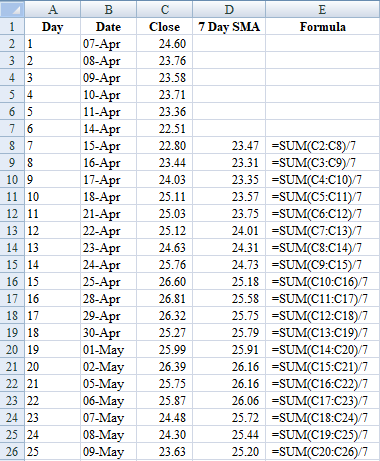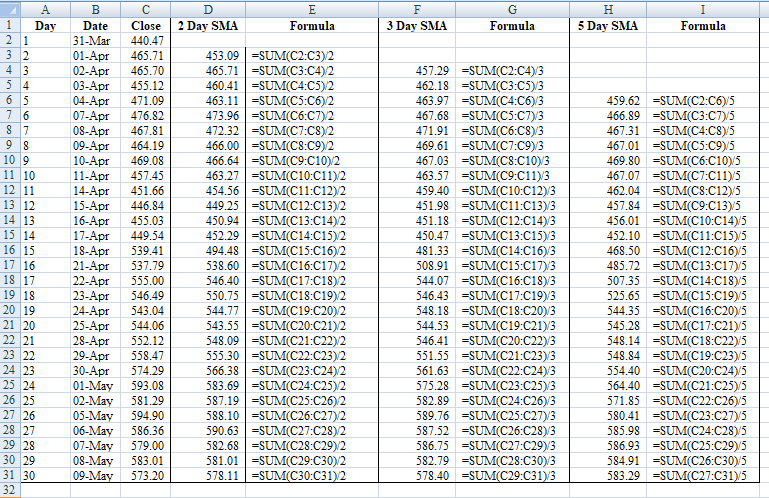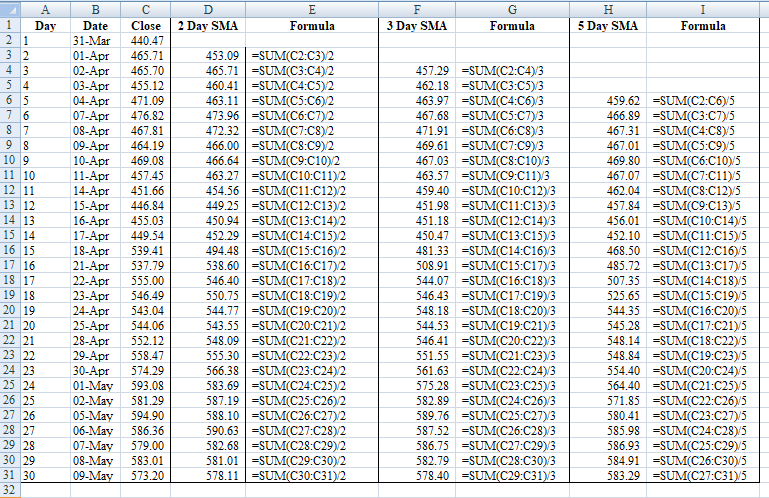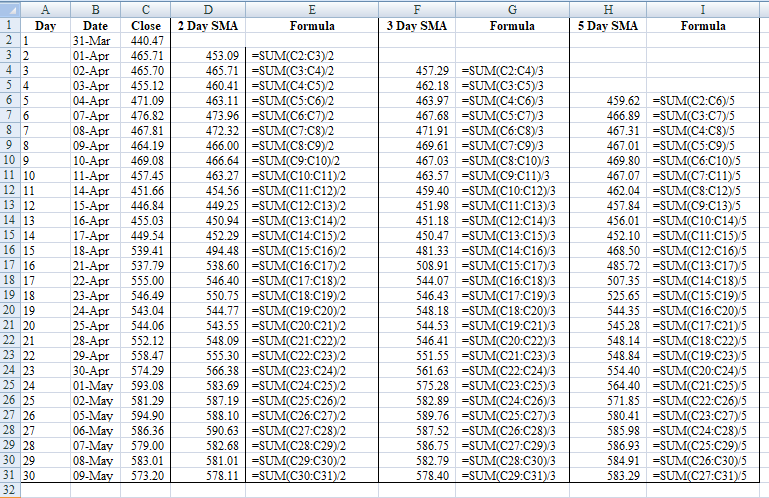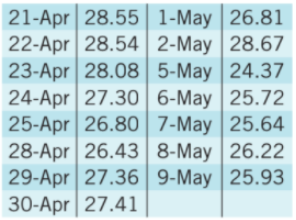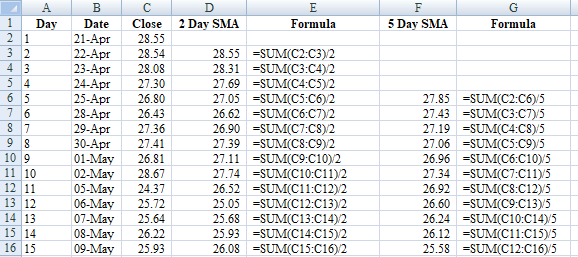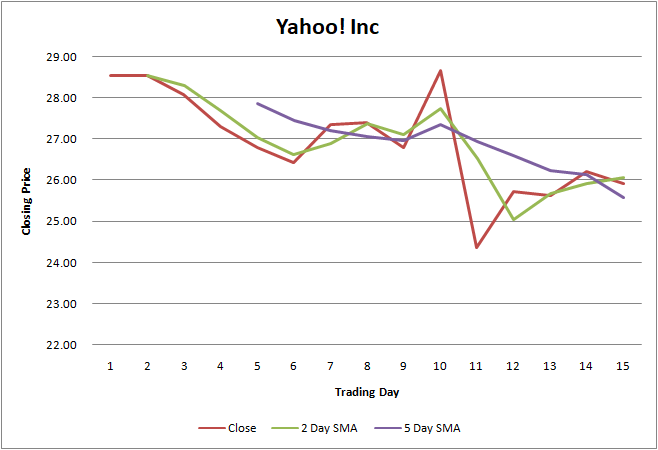Cengage Financial Algebra 1st Edition Chapter 3 Exercise 3.5 Banking Services
Page 145 Problem 1 Answer
Given: Rico deposits $800 at 3.87% interest, compounded quarterly.
We have to find his ending balance after one year.
We will use above formula.
Here,
P=800
r=.0387
n=12
⇒FV=800∗1.00322512
⇒FV=$831.515
Therefore, His ending balance after one year is$831.515
Read and Learn More Cengage Financial Algebra 1st Edition Answers
Page 146 Problem 2 Answer
Given: Kate deposits $2,350 in an account that earns interest at a rate of 3.1%, compounded monthly.
We have to find her ending balance after five years.
We will use above formula.
Here,t=5
P=2,350
r=.031
n=12
⇒FV=2350∗1.002560
⇒FV=$2,743.45
Therefore, Her ending balance after five years is$2,74345

Cengage Financial Algebra Chapter 3.5 Banking Services Guide
Cengage Financial Algebra 1st Edition Chapter 3 Exercise 3.5 Banking Services Page 147 Problem 3 Answer
Given; Barbara deposits 3,000 in a one-year CD at 4.1 % interest, compounded daily.
To find: What is the APY to the nearest hundredth of a percent?
The APY using the compound interest formula and the simple interest formula.
B=p(1+r/n)nt
B=3,000(1+0.041/365)365×1
B=3125
I=3125−2,000
=125
I=prt
=I/pt
=125/3,000×1
=0.041%
r= 4.1 %
The annual percentage yield is 4.10 %
APY can also be found by using the formula APY (1+r/n)n−1
APY=(1+r/n)n−1
APY=(1+0.041/365)365−1
APY≈0.041=4.1%
The annual percentage yield is 4.1 %, which is the same as the previous answer
Hence The APY to the nearest hundredth of a percent is found to be 4.10 %
Page 145 Problem 4 Answer
Given; One is an account that pays 2.78 % compounded daily. The other account pays 3.25 % compounded quarterly.
To find: Would either of these accounts provide Nancy with a better return than her current account? If so, which account?
To find which account earns the most money compute the ratio of A/P for each account then compare them.
For the second account: r=2.78% and the compound rate is continuous, therefore:
A/P=e2.78%≈1.028
For the Second account:r=3.25% and n=4 therefore:A/P
=(1+3.25%/4)4 ≈1.032
1.032>1.028
The second account earns more money because its ratio of Future Value to Initial Value higher than the other account.
Hence we conclude that The second account earns more money because its ratio of Future Value to Initial Value higher than the other account.
Solutions For Exercise 3.5 Financial Algebra 1st Edition
Cengage Financial Algebra 1st Edition Chapter 3 Exercise 3.5 Banking Services Page 146 Problem 5 Answer
Given; The ending balance after k years of an account that starts with a balance of 2,000 $ and earns interest at a rate of3.5 %, compounded daily.
To find: Write an algebraic expression
we have given
P=2000,
r=0.035,
t=k
A(t)=P⋅er⋅(t)
A(t)=2000⋅e0.035⋅(t)
A(k)=2000⋅e0.035⋅(k)
Hence an algebraic expression for the ending balance after k years of an account that starts with a balance of 2,000 and earns interest at a rate of 3.5 %, compounded daily.
will be given by A(k)=2000⋅e0.035⋅(k)
Page 147 Problem 6 Answer
Given ; Consider an amount x deposited into a CD at 2.4 % interest compounded daily, and the same amount deposited into a CD at the same rate that compounds monthly.
To find : Explain why, after 1 year, the balance on a CD that compounds daily is greater than the CD that compounded monthly.
Find the APY using the compound interest formula and the simple interest formula.
B=p(1+r/n)nt
B=x(1+0.024/365)365×1
Subtract the principal from the new balance.
I = x(1+0.024/365)365×1
=x(1+0.024/365)365×1
−x/x×1
APY can also be found by using the formula APY=(1+r/n)n−1 is the interest rate and n is the number of times interest is compounded per year.
1-Year CD with both of them at the same 2.4 % APR interest rate, and compare how much interest you have at the end of the year. Both credit interest monthly.
Since MoBank compounds monthly, you are getting 2.4 5/12 =0.002 every month.
so it much less that the daily compounded interest Since MoBank compounds monthly, we are getting 2.4 % /12= 0.002 every month.
so it much less that the daily compounded interest
Page 148 Problem 7 Answer
According to question,
The words imply that if you want to earn a lot of money through interest, then you need to start with a lot of money.
As we know that, This means that you will not get rich from bank interest alone, because the interest rates are often quite small and you can earn much more from other business investments.
However, business investments contain a lot more risk compared to interest.
Hence, The required answer is:
You will not get rich from bank interest alone .
Cengage Financial Algebra 1st Edition Chapter 3 Exercise 3.5 Banking Services Page 148 Problem 8 Answer
Given: p=4,000 Rate percent
Find: What is his balance, to the nearest cent, at the end of 10 years.
According to question,
B=p(1+r/n)nt
=4000(1+0.05/2)2×10
=4000(1+0.025)20
=4000(1.025)20
≈6554.47
Hence, Balance, to the nearest cent, at the end of 10 years is:$6,554.47
Page 148 Problem 9 Answer
Given: On Olga′s 16 th birthday, her uncle invested $2,000 in an account that was locked into a 4.75% interest rate, compounded monthly.
Find:How much will Olga have in the account when she turns 18? Round to the nearest cent.
According to question,
B=p(1+r/n)nt
=2000(1+0.0475/12)12×2
=2000(1+0.0475/12)24
≈2198.91
Hence, The required answer is: $2,198.91
Page 148 Problem 10 Answer
Given: Samantha deposits $1,500 into the Park Street Bank. The account pays 4.12% annual interest, compounded daily. To the nearest cent,
Find: To the nearest cent, how much is in the account at the end of three non-leap years
According to question,
B=p(1+r/n)nt
=1500(1+0.0412/365)365×3
≈1697.33
Hence, The required answer is: $1,697.33
Cengage Financial Algebra 1st Edition Chapter 3 Exercise 3.5 Banking Services Page 148 Problem 11 Answer
Given: Joanne deposits $4,300 into a one−year CD at a rate of 4.3%, compounded daily.
Find: What is her ending balance after the year.
According to question,
B=p(1+r/n)nt
=4300(1+0.043/365)365×1
≈4488.92
Hence, The required answer is: $4,488.92
Page 148 Problem 12 Answer
Given: Joanne deposits $4,300 into a one−year CD at a rate of 4.3%,
Find:How much interest does she earn.
According to question,
B=p(1+r/n)nt
=4300(1+0.043/365)365×1
≈4488.92
Then,The interest is the difference between the new balance and the principle:
I=B−p
=4488.92−4300
=188.92
Hence, The required answer is: $188.92
Chapter 3 Exercise 3.5 Banking Services Walkthrough Cengage
Cengage Financial Algebra 1st Edition Chapter 3 Exercise 3.5 Banking Services Page 148 Problem 13 Answer
Given: Joanne deposits $4,300 into a one−year CD at a rate of 4.3%, compounded daily.
Find:What is her annual percentage yield to the nearest hundredth of a percent.
According to question,
By usiing the annual percentage yield formula to determine the APY:
APY=(1+r/n)n−1
=(1+0.043/365)365−1
≈1.0439−1
=0.0439
=4.39%
Hence, Annual percentage yield to the nearest hundredth of a percent is:=4.39%
Page 148 Problem 14 Answer
Given: Mike deposits $5,000 in a three−year CD account that yields 3.5% interest, compounded weekly.
Find: What is his ending balance at the end of three years.
According to question,
B=p(1+r/n)nt
=5000(1+0.035/52)52×3
≈5553.36
Hence, The required answer is: $5,553.36
Cengage Financial Algebra 1st Edition Chapter 3 Exercise 3.5 Banking Services Page 148 Exercise 1 Answer
Given: Mike and Julie receive $20,000 in gifts from friends and relatives for their wedding.
Find: Will their money double in fourteen years
p= Principal=$20,000
r=Interest rate=4.75%=0.0475
t=Time expresses in years=14 years
(Given) Then, By using the formula,
B=p(1+r/n)nt
=20000(1+0.0475/365)365×14
≈38888.12
Hence, the balance in 14 years is$38,888.12, which is not the double of the principle of$20,000 and thus the money was not doubled in 14 years..
Hence, The required answer is: No
Page 148 Exercise 2 Answer
Given:
p= Principle =$20,000
r= Interest rate =4.75%=0.0475
t= Time expressed in years =15 years
Find: Will their money double in fifteen years.
According to question,
B=p(1+r/n)nt
=20000(1+0.0475/365)365×15
≈40779.76
Then, the balance in 15 years is$40,779.76, which is more than the double of the principle of$20,000 and thus the money was doubled in 15 years.
Hence, The required answer is: Yes.
Cengage Financial Algebra 1st Edition Chapter 3 Exercise 3.5 Banking Services Page 149 Exercise 3 Answer
Given:p= Principle =$5,000r= Interest rate =6%=0.06t= Time expressed in years =1 year
Find: the simple interest for a one-year CD for $5,000 at a 6% interest rate.
Given:p= Principle =$5,000r= Interest rate =6%=0.06t= Time expressed in years =1 year
(Given) Then,by using the formula:
I=prt
=5000×0.06×1
=300
Hence, The simple interest is:$300
Page 149 Exercise 4 Answer
Given: CD for $5,000 at an interest rate of 6%, compounded annually.
Find: the interest for a one-year.
According to question,
B=p(1+r/n)n t
=5000(1+0.06/1)1×1
=5000(1.06)
=5300
Then, The interest is the difference between the balance and the principle:
I=B−p
=5300−5000
=300
Hence, The interest is:=300
Cengage Financial Algebra 1st Edition Chapter 3 Exercise 3.5 Banking Services Page 149 Exercise 5 Answer
Then, We note that the results of part (a) and (b) are both$300, which implies that the simple interest formula and the compound interest formula result in the same interest when the time is l year and the compounding occurs annually.
Hence, Both the result is same.
Page 149 Exercise 6 Answer
Given:CD for $5,000 at an interest rate of 6%.
Find: Simple interest.
According to question,
I=prt
=5000×0.06×3
=900
Hence, The interest is:$900
Page 149 Exercise 7 Answer
Given:$5,000 at an interest rate of 6%, compounded annually.
Find: the interest for a three-year.
According to question,
B=p(1+r/n)n t
=5000(1+0.06/1)1×3
=5000(1.06)3
=5955.08
Then,The interest is the difference between the balance and the principle:
I=B−p
=5955.08−5000
=955.08
Hence, The interest is:$955.08
Cengage Financial Algebra Banking Services Exercise 3.5 Solutions
Cengage Financial Algebra 1st Edition Chapter 3 Exercise 3.5 Banking Services Page 149 Exercise 8 Answer
According to question,
We note that the result of part (e) is higher than the result of part (d), which implies that the compound interest is higher than the simple interest when the time is longer than 1 year and when the compounding is annually.
Therefore, compound in part (e) is higher.
Page 149 Exercise 9 Answer
Given: CD for $5,000 at an interest rate of 4%.
Find: The simple interest.
According to question,
I=prt
=5000×0.04×6
=1200
Hence, The simple interest is:$1,200
Page 149 Exercise 10 Answer
Given:$5,000 at an interest rate of 4%, compounded annually
Find The interest.
B=p(1+r/n)nt
=5000(1+0.04/1)1×6
=5000(1.04)6
≈6326.60
Then, The interest is the difference between the balance and the principle:
I=B−p
=6326.60−5000
=1326.60
Hence, The interest is:
$1,326.60
Cengage Financial Algebra 1st Edition Chapter 3 Exercise 3.5 Banking Services Page 149 Exercise 11 Answer
According to question,
We note that the result of part (h) is higher than the result of part (g), which implies that the compound interest is higher than the simple interest when the time is longer than 1 year and when the compounding is annual.
Hence, Compound interest in part (h) is higher.
Page 149 Exercise 12 Answer
According to question,
No, compound interest is not the same as sample interest when compounding annually, specifically when the time is more than 1 year.
This is due to the fact that the interest will earn more interest in the future when using compound interest .
Hence, The required answer is:No
Page 149 Exercise 13 Answer
Given: Rodney invests a sum of money, P, into an account that earns interest at a rate of r, compounded yearly.
Gerald invests half that amount into an account that pays twice Rodney′s interest rate
Find: Which of the accounts will have the higher ending balance after one year.
According to the question, Firstly we can calculate for Rodney:
B=p(1+r/n)nt
=P(1+r/1)1×1
=P(1+r)
=P+Pr
Then we can calculate for Gerald:
B=p(1+r/n)nt
=P/2(1+2r/1)1×1
=P/2(1+2r)
=P/2+Pr
Then comparison is:
Rodney has a higher ending balance.
Hence, Rodney has a higher ending balance.
Cengage Financial Algebra 1st Edition Chapter 3 Exercise 3.5 Banking Services Page 149 Exercise 14 Answer
Given: Island Bank is advertising a special 6.55% APR for CDs. Manny takes out a one−year CD for $40,000. The interest is compounded daily
Find the annual percentage yield for Manny’s account to the nearest hundredth of a percent.
According to question,
APY=(1+r/n)n−1
=(1+0.0655/365)365−1
≈1.0677−1
=0.0677
=6.77%
Hence, the annual percentage yield for Manny’s account to the nearest hundredth of a percent is=6.77%
Page 149 Exercise 15 Answer
Given: An elite private college receives large donations from successful alumni.
The account that holds these donations has $955,000,000 currently.
Find: How much would the account earn in one year of simple interest at a rate of 5.33%.
According to question,
I=prt
=955,000,000×0.0533×1
=50,901,500
Hence, The simple interest is: $50,901,500
Page 149 Exercise 16 Answer
Given: An elite private college receives large donations from successful alumni.
The account that holds these donations has $955,000,000 currently.
Find: How much would the account earn in one year at 5.33% if the interest was compounded daily.
According to question,
B=p(1+r/n)nt
=955,000,000(1+0.0533/365)365×1
≈1,007,278,530.91
Then,The interest is the difference between the balance and the principle:
I=B−p
=1,007,278,530.91−955,000,000
=52,278,530.91
Hence, The required answer is: $52,278,530.91
Page 149 Exercise 17 Answer
Given: An elite private college receives large donations from successful alumni. The account that holds these donations has $955,000,000 currently.
Find: How much
According to question,
Result of first part is:$50,901,500 (simple interest)
Result of second part:$52,278,530.91 (compounded daily)
The differences of the interests:
$52,278,530.91−$50,901,500=$1,377,030.91
Hence, As we note that the compounded daily earns$1,377,030.91 more than the simple interest.
Hence,$1,377,030.91 more interest is earned by compounded daily as compared to simple interest.
How To Solve Cengage Financial Algebra Chapter 3.5 Banking Services
Cengage Financial Algebra 1st Edition Chapter 3 Exercise 3.5 Banking Services Page 149 Exercise 18 Answer
Given: An elite private college receives large donations from successful alumni.
The account that holds these donations has $955,000,000 currently.
Find: If the money is used to pay full scholarships, and the price of tuition is $61,000 per year to attend, how many more students can receive full four-year scholarships if the interest was compounded daily rather than using simple interest.
According to question,Result of first part is:$50,901,500 (simple interest)
Result of second part is:$52,278,530.91 (compounded daily)
The differences of the interests:
$52,278,530.91−$50,901,500=$1,377,030.91
Hence, As we have $1,377,030.91 more when using daily compounding.
Then according to question,Every student receives a tuition of $61,000per year, which is thus$61,000×4=$244,000 per full four-year scholarship.
Then, The number of additional students that can then receive a full four-year scholarship are then the additional interest divided by$244,000.
$1,377,030.91
$244,000≈5.6436≈5
Therefore, 5 more students can receive a full four-year scholarship.
Hence,5 more students can receive a full four-year scholarship.



